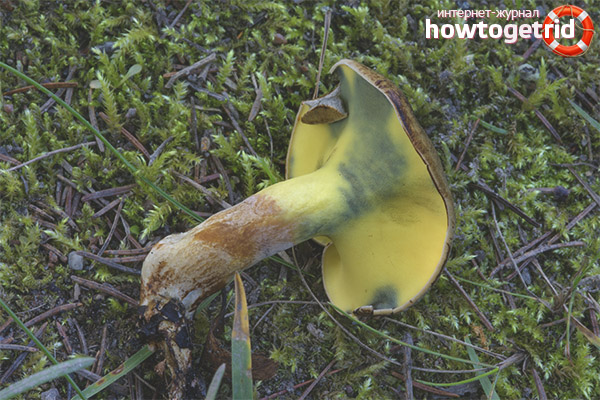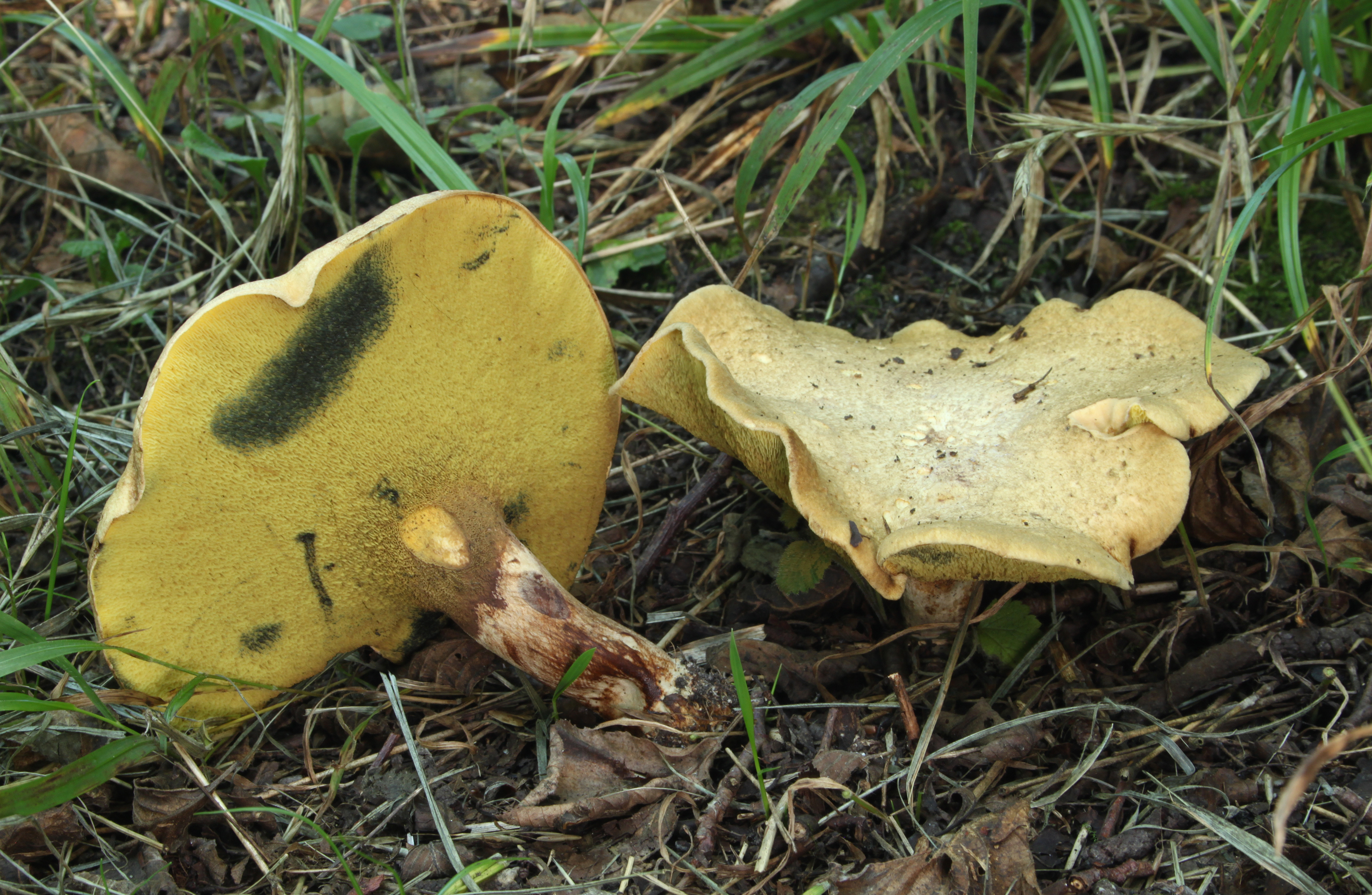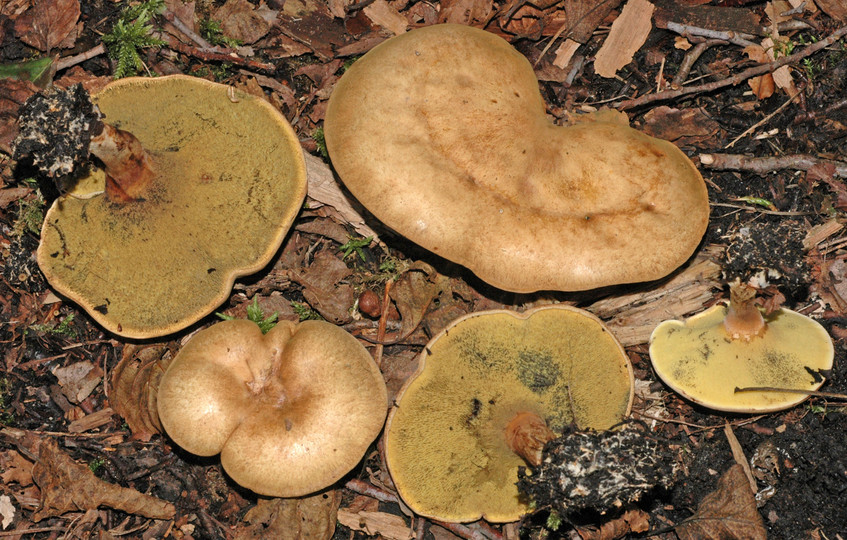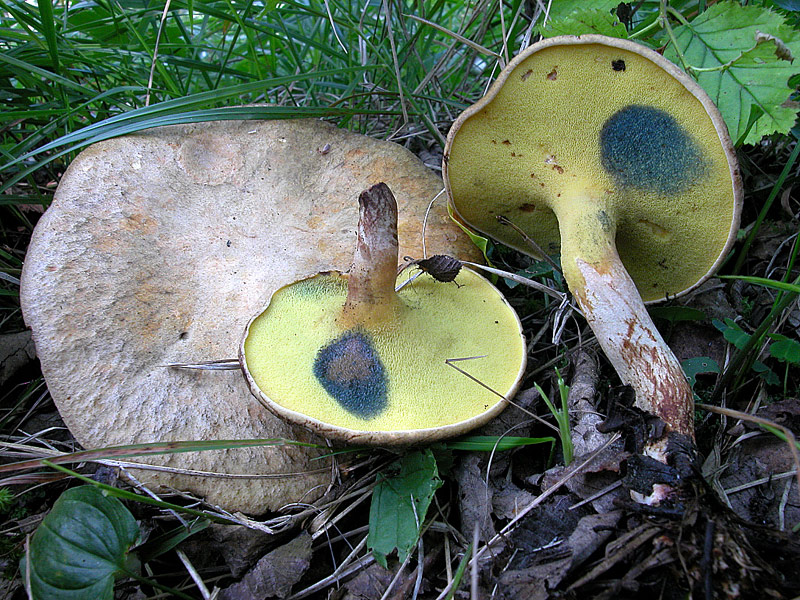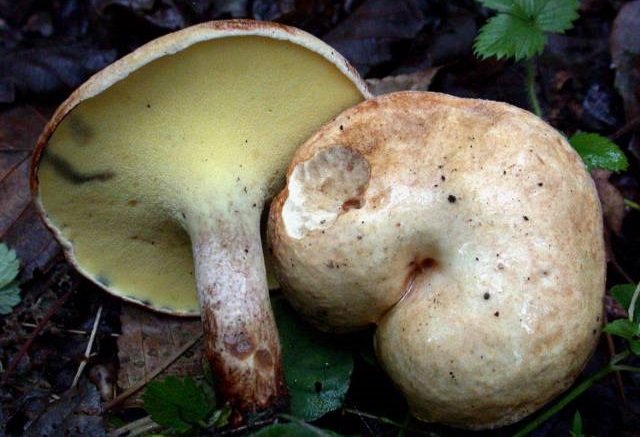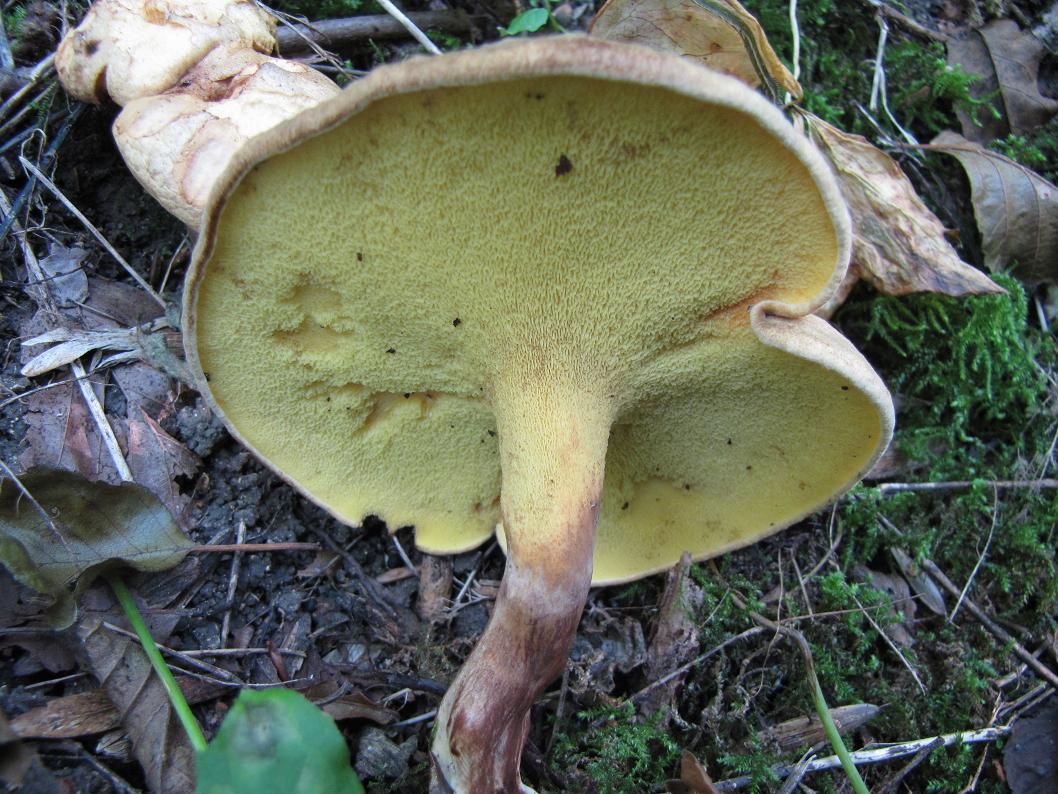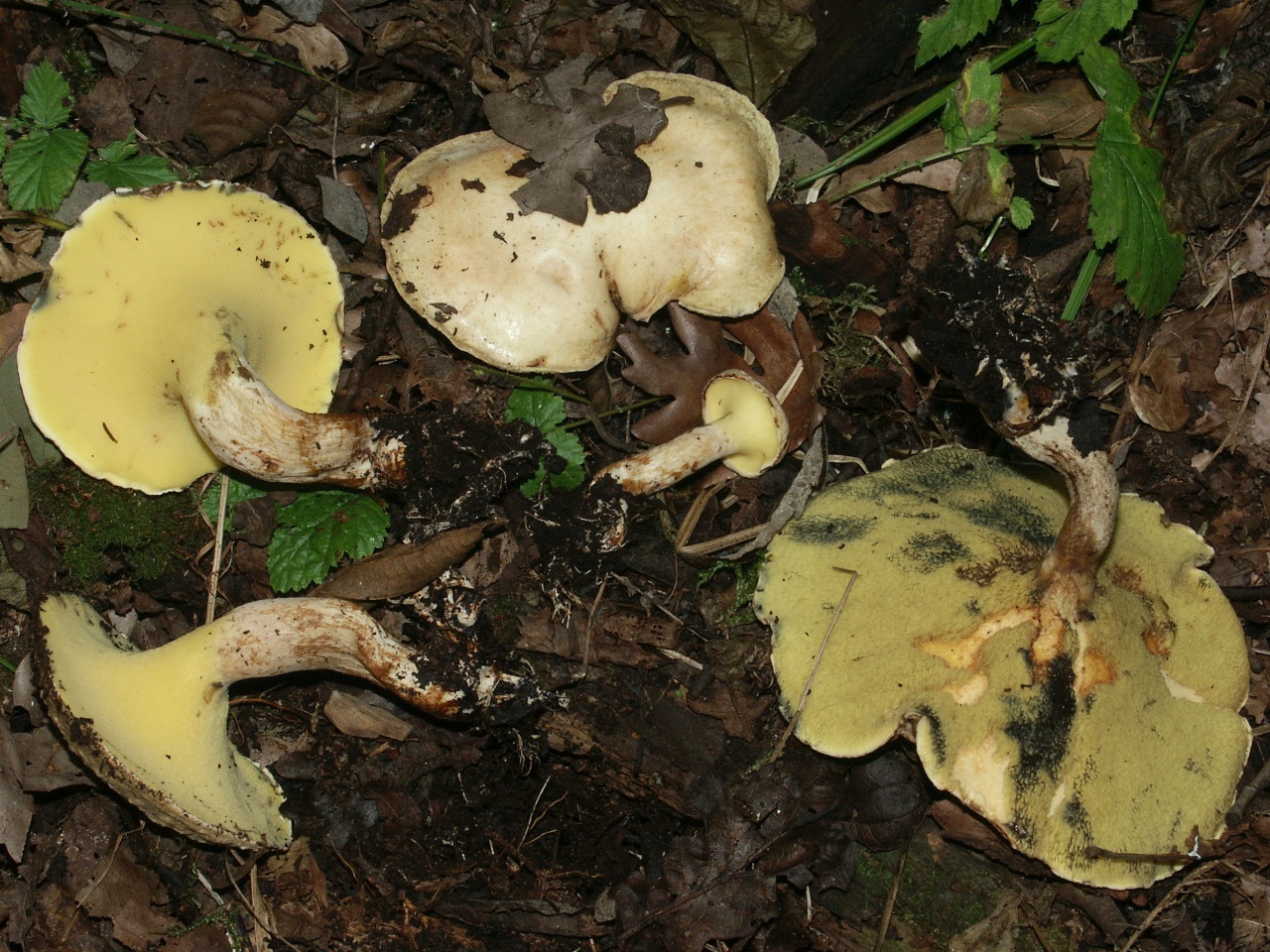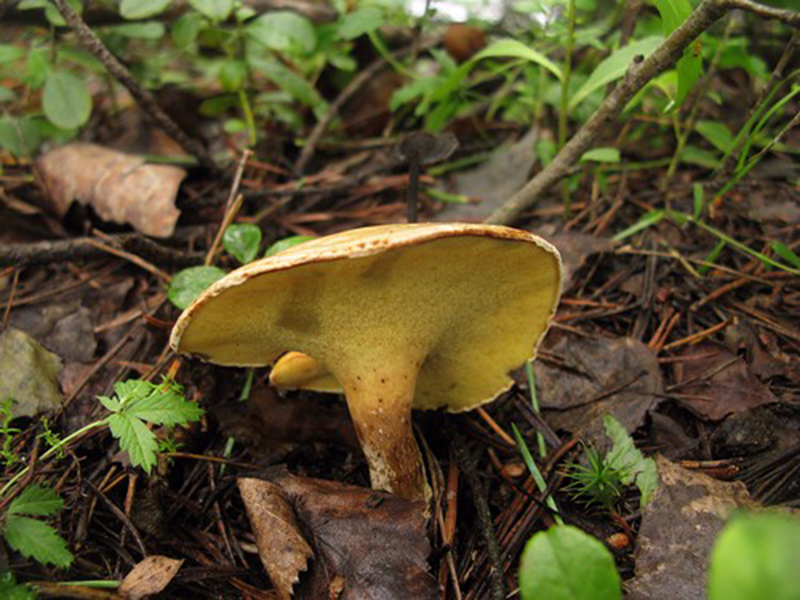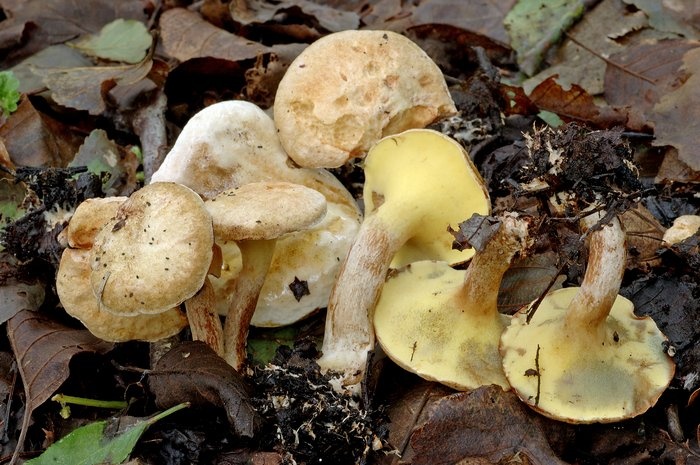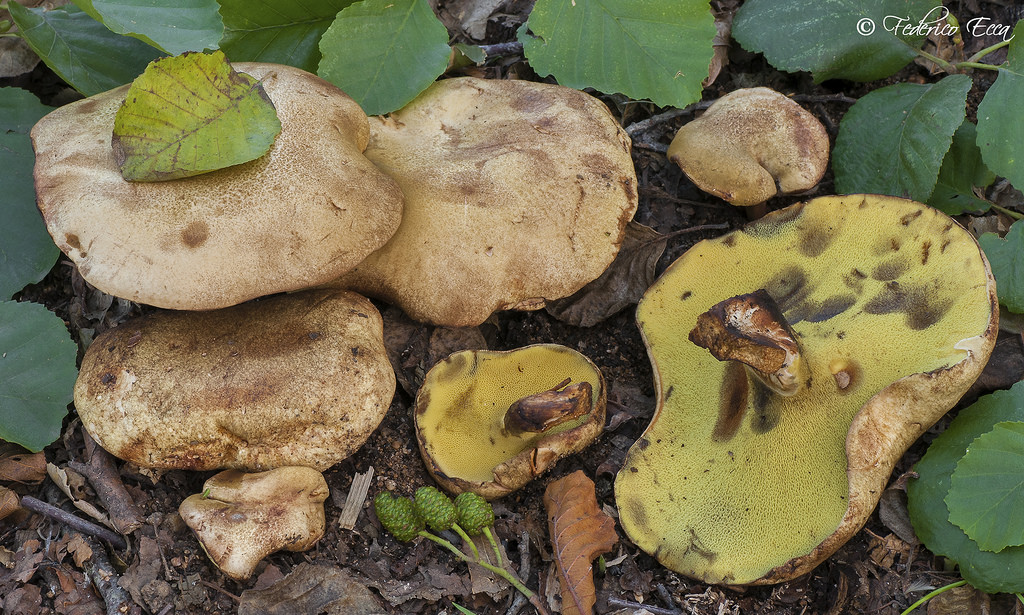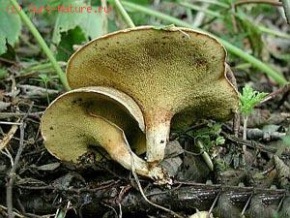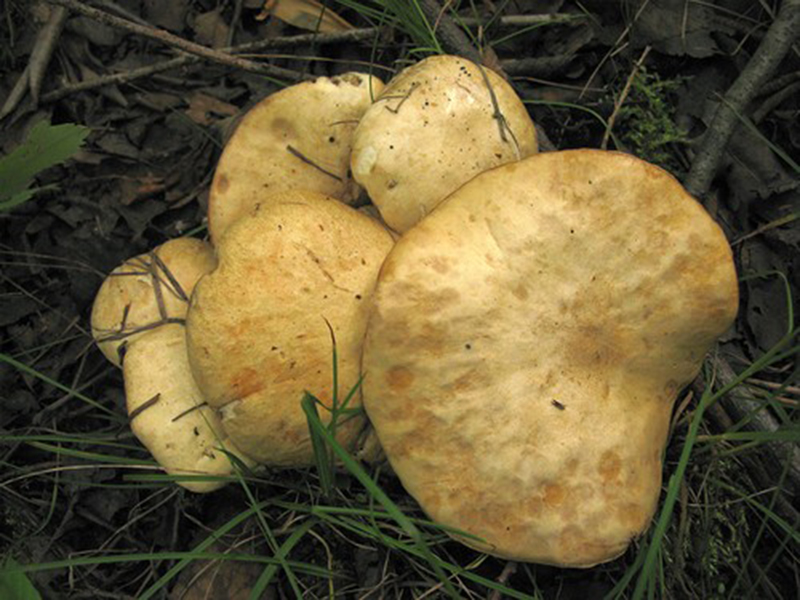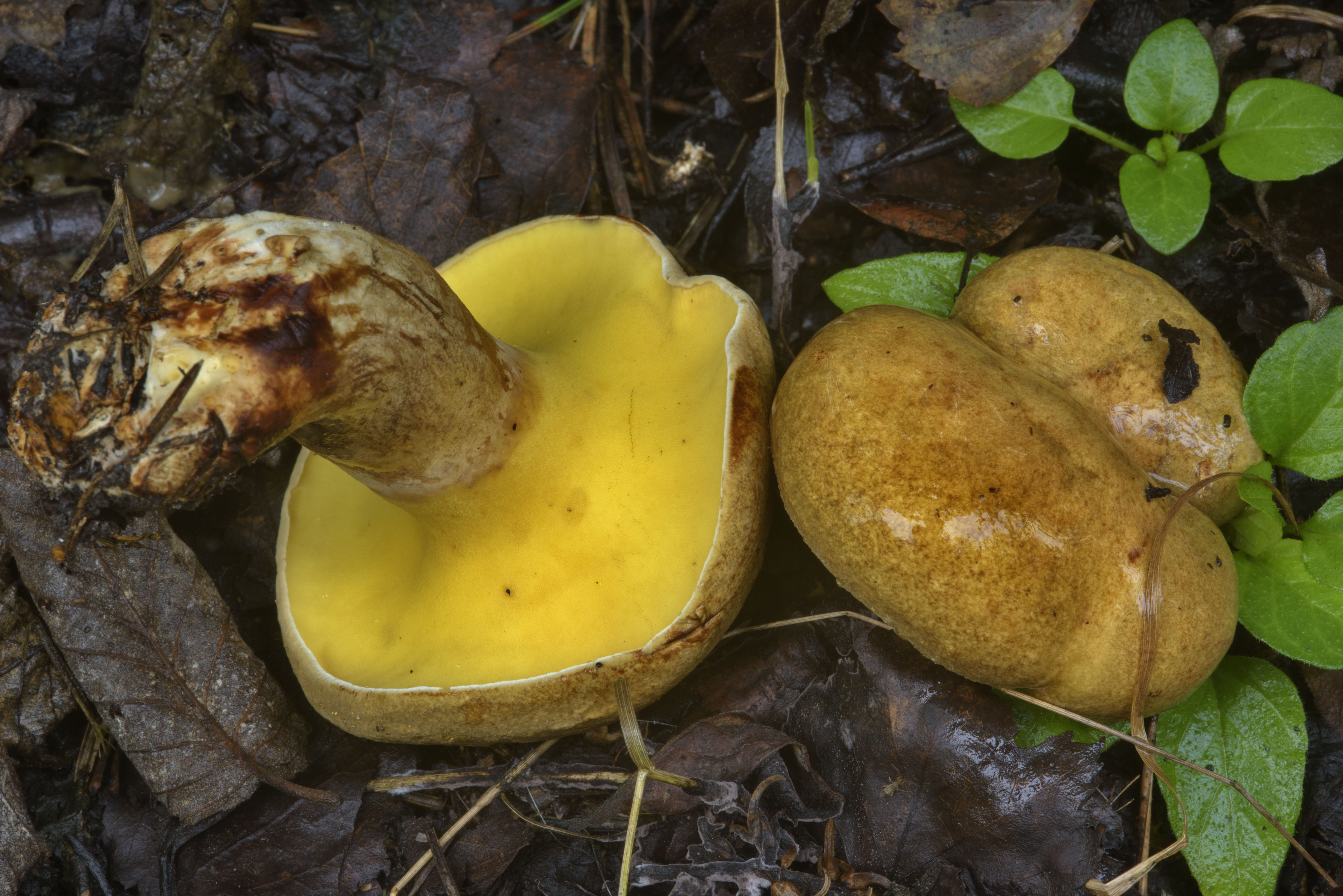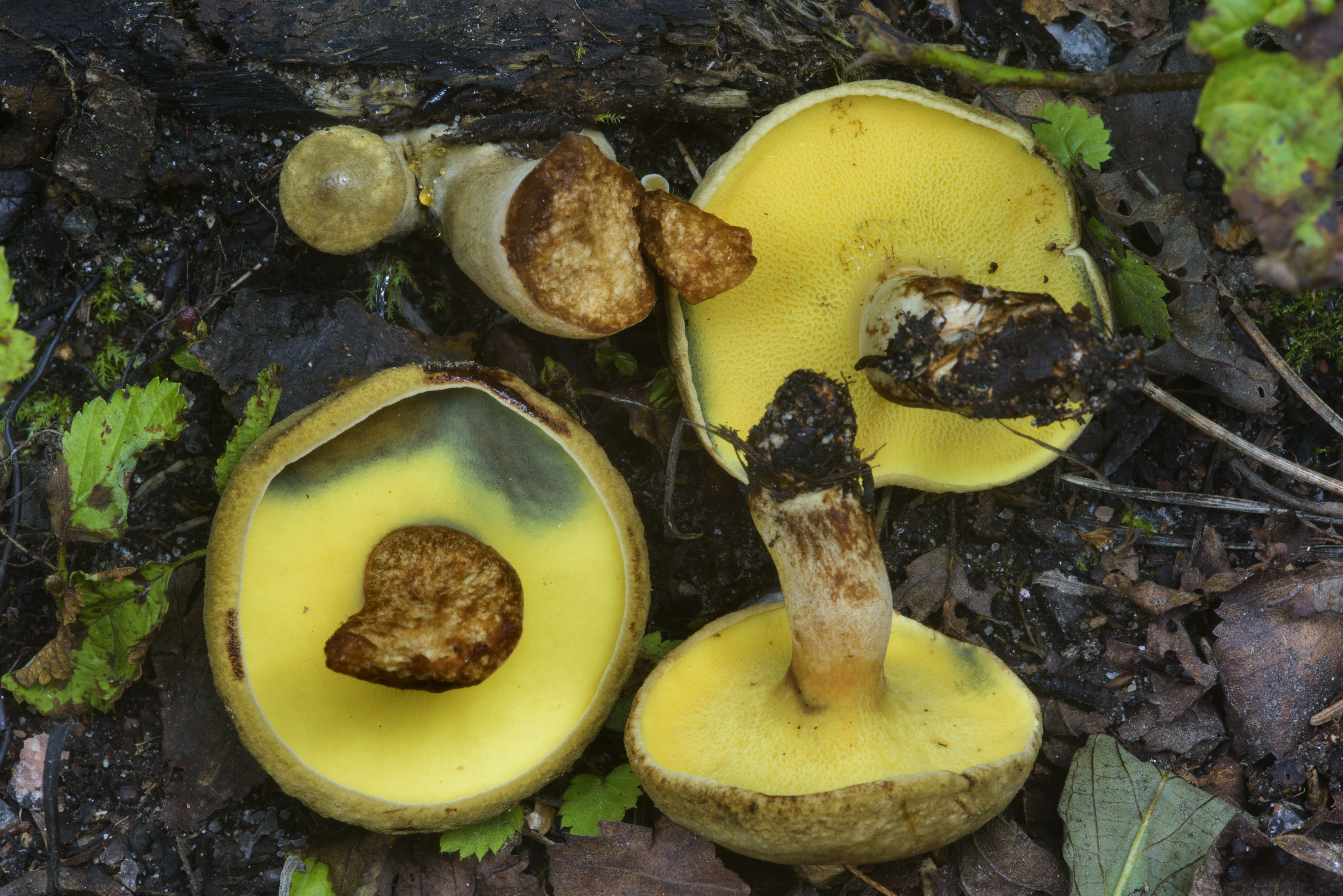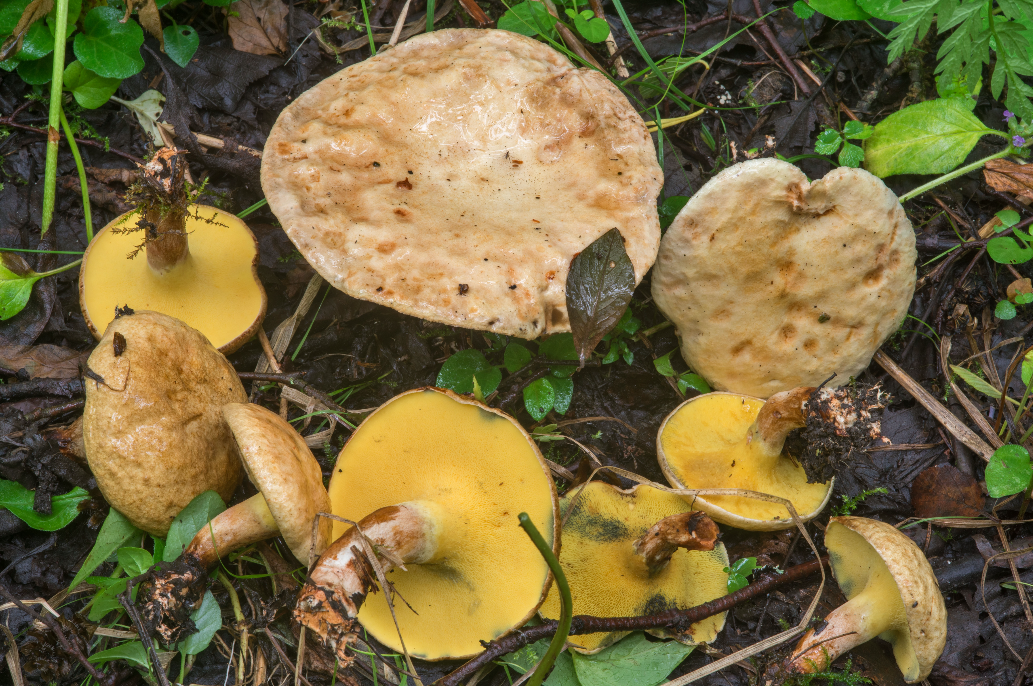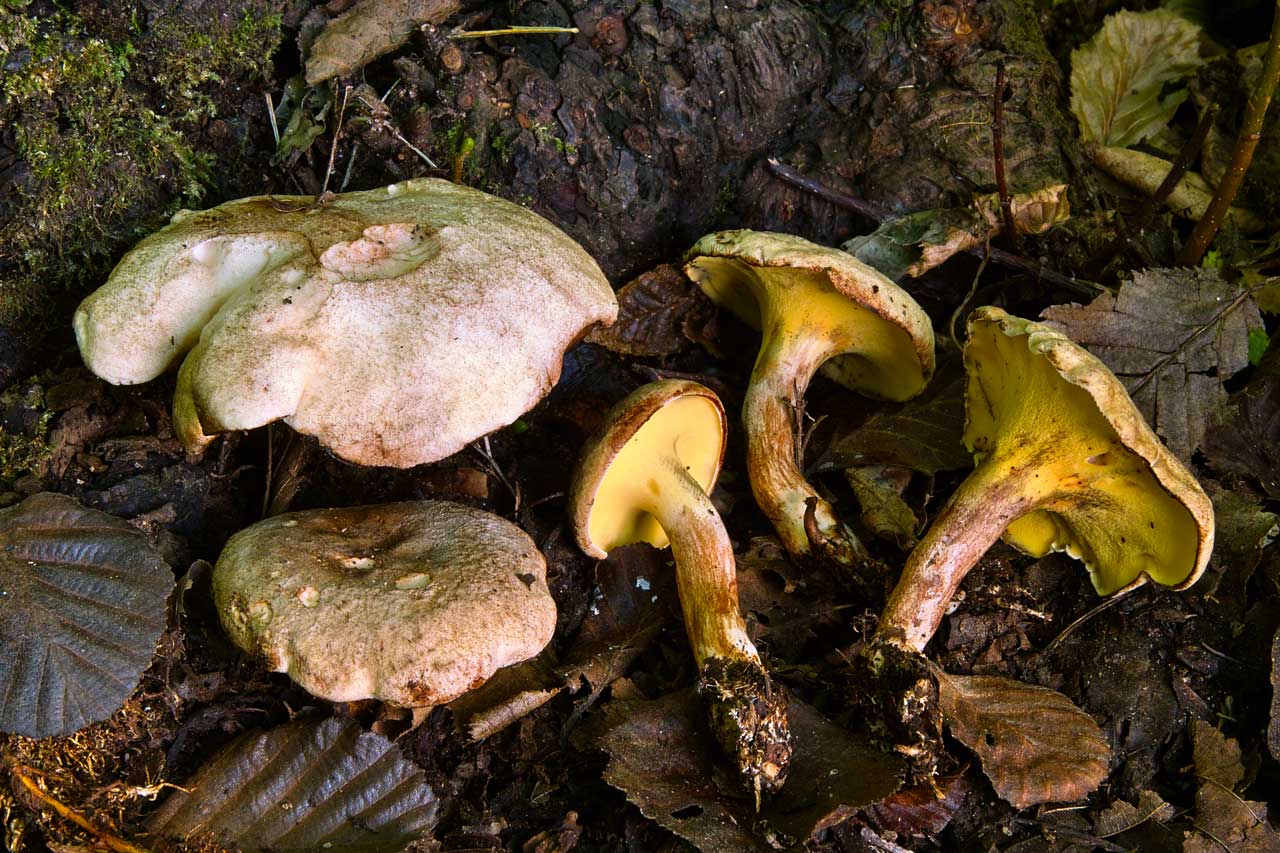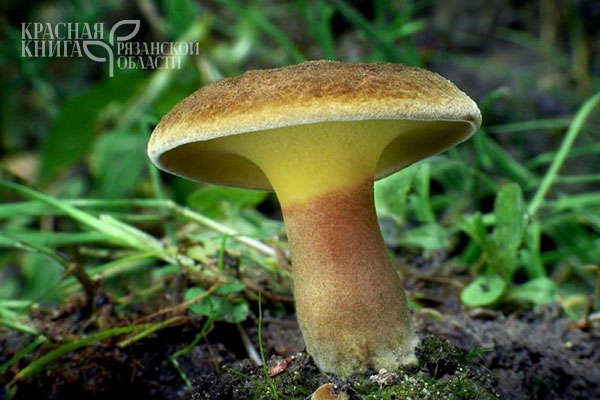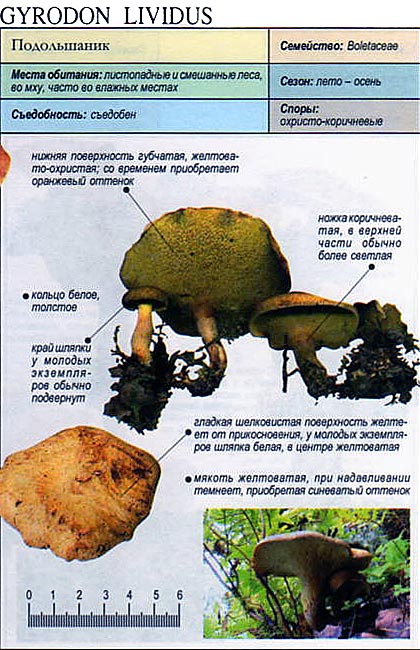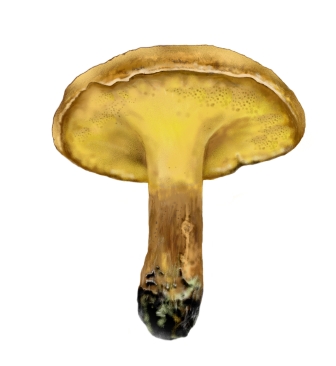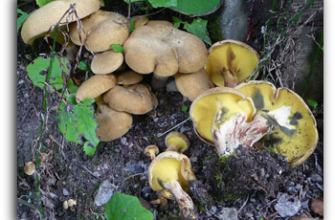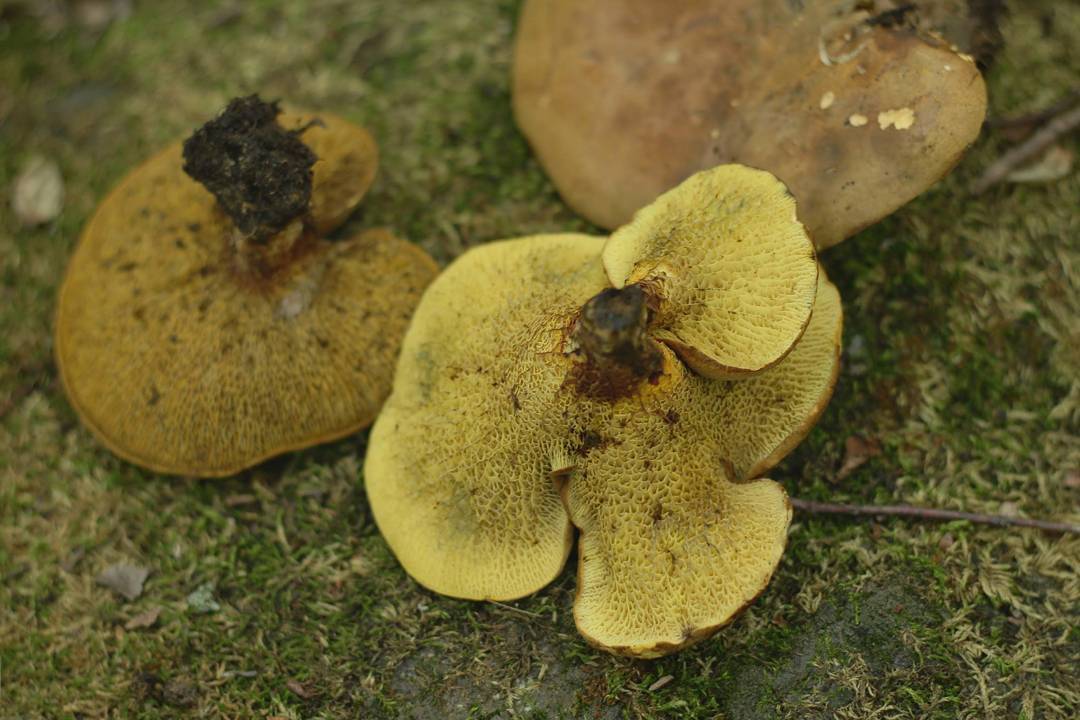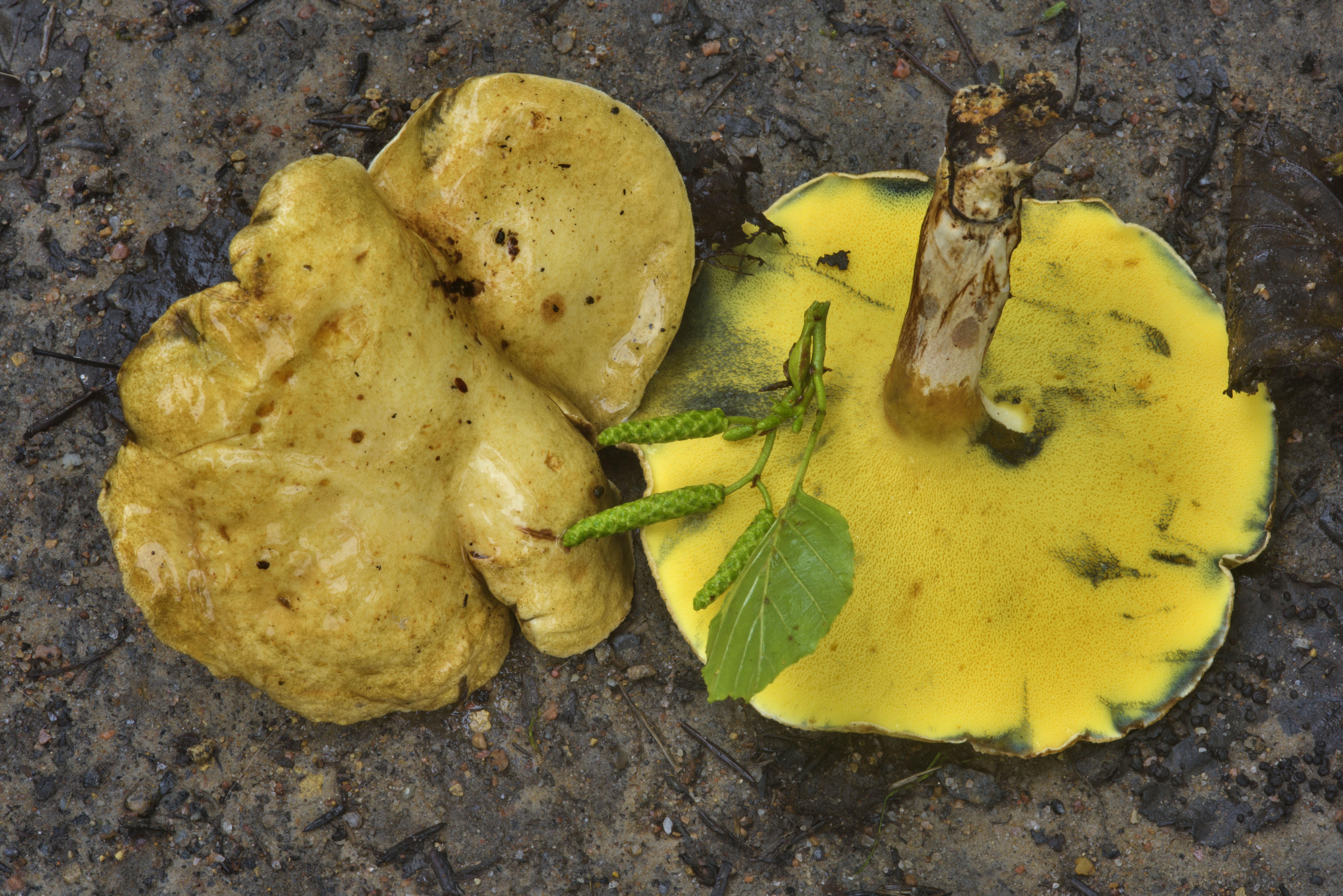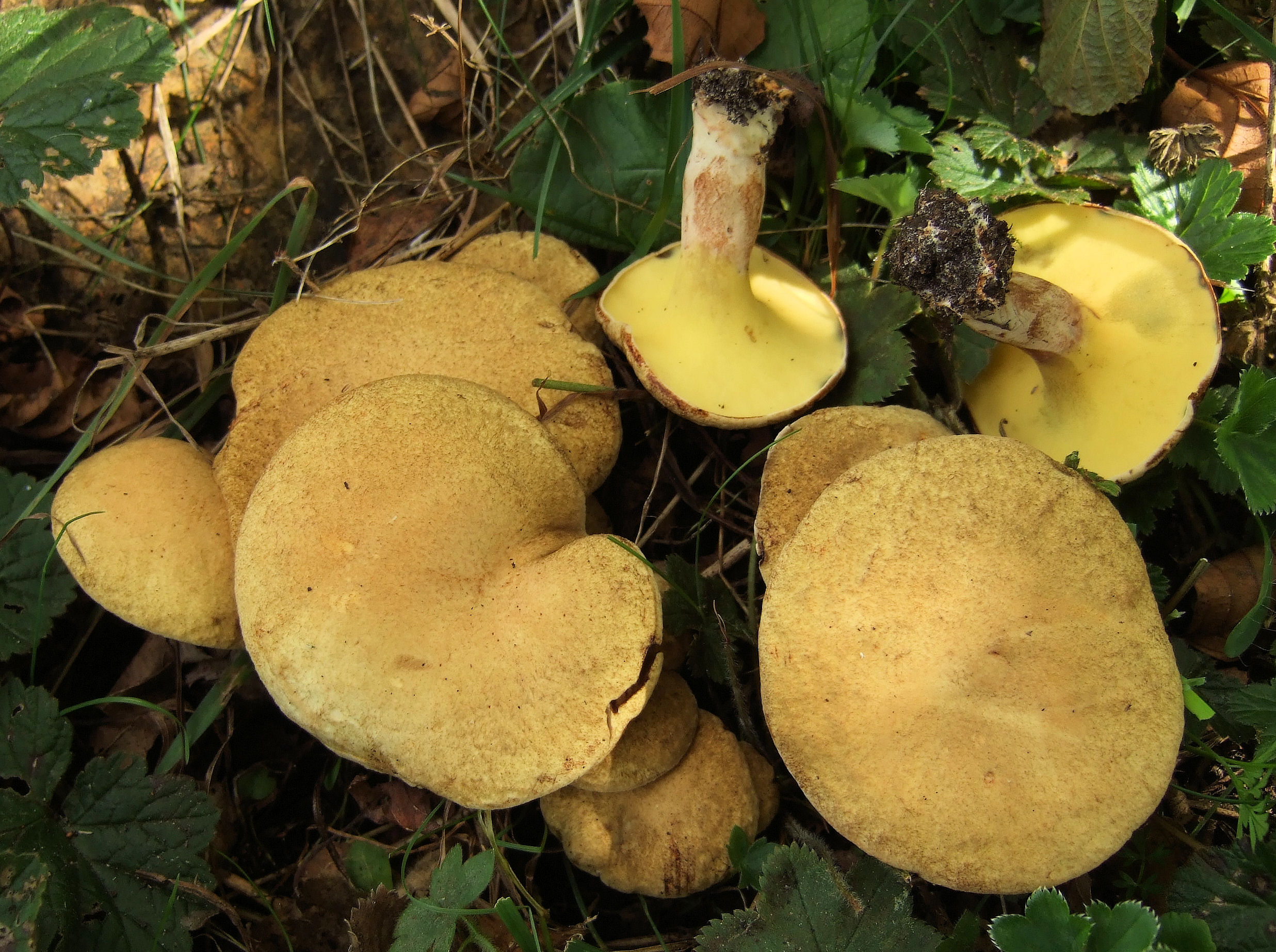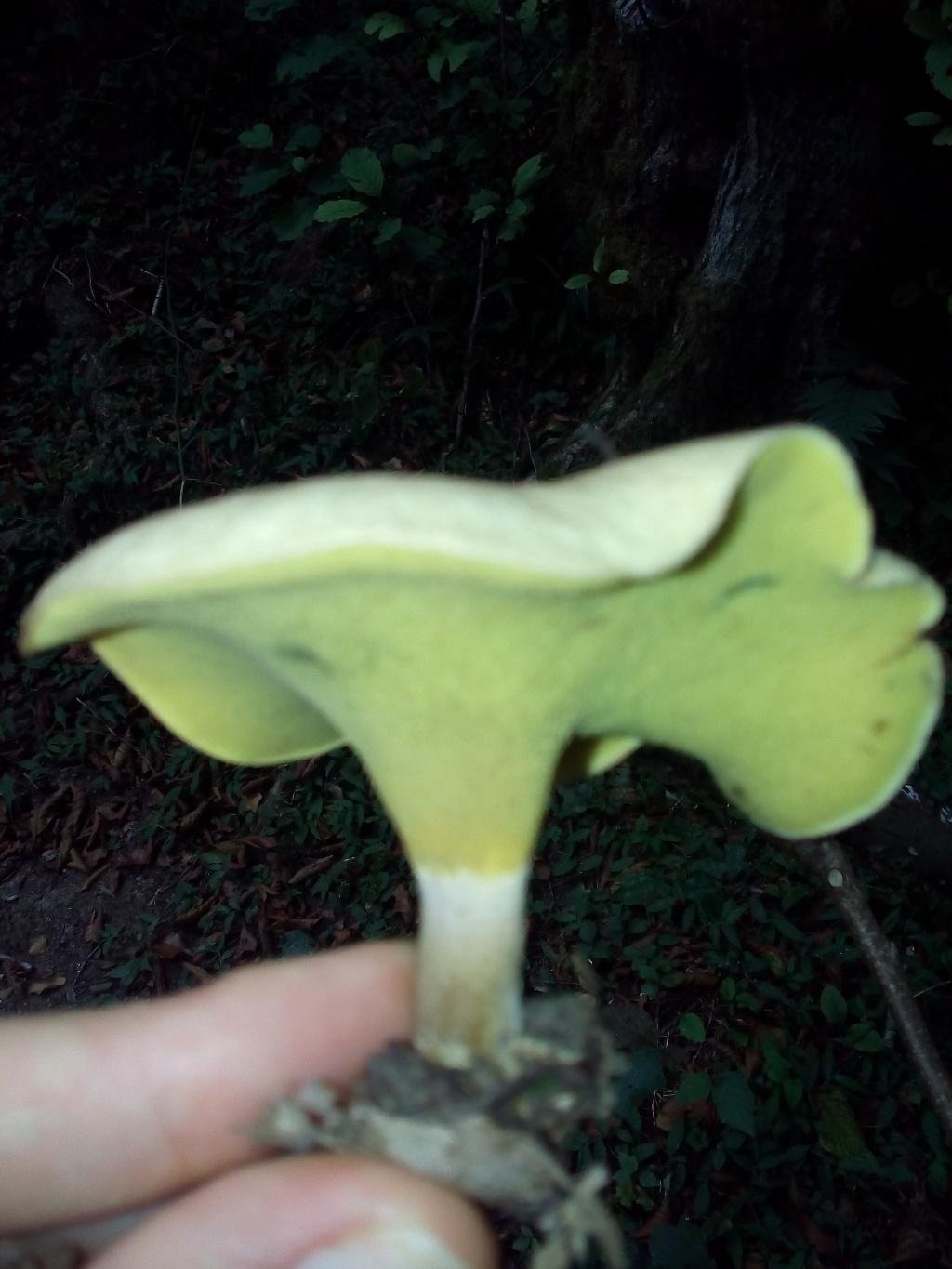Description
Podalder is a typical cap-peduncular mushroom with a tubular hymenophore.
Hat
The shape of the cap with age gradually changes from convex to almost flat. Its surface is uneven, dry in the absence of precipitation, and sticky in rainy weather. Color - brownish or reddish gray. The size can be up to 15 cm in diameter.
Leg
Reddish spots are often observed on the surface of the leg. There are never velum remnants on the leg of the alder, the surface of the leg is smooth.
Pulp
The flesh of the alder stands is yellowish, in the area of the cap it turns blue when damaged. The stem is brownish and unchanged in color when cut. Does not possess any pronounced taste and smell.
What does the glaucous gyrodon look like?
The cap of a young Basidiomecet has a semicircular shape. Over time, it becomes cushion, slightly depressed in the center. Its diameter can range from 3 to 15 cm.
The edges of the cap are thinned, slightly tucked up, later acquire a wavy shape
The surface of the mushroom is dry, velvety, and becomes smooth over time. At high air humidity, the skin of glaucous gyrodon becomes sticky.
The color of the cap of the young copy is sandy, olive, light. In the old fruiting body, it becomes rusty-brown, yellow, dark.
The reverse side of the cap is covered with a thin layer of hymenophore, which is formed from thin and short tubes descending to the pedicle and growing to it. They form large labyrinthine pores, first golden and then dark olive. If you press on the surface of the hymenophore, it will turn blue or green, and eventually turn brown altogether.
The leg grows cylindrical, thinner at the base, its location is central. At first it is even, but over time it bends and becomes thinner. Its length does not exceed 9 cm, and its thickness is 2 cm.
In young specimens, the leg is covered with a mealy bloom, over time it becomes completely smooth. Its color is always identical to the color of the cap, but it also happens a little lighter.
The upper part of the leg is solid yellow, this is due to the downward hymenophore
The spongy, friable, fleshy flesh of the glaucous gyrodon cap is almost always pale and yellow. On the leg, it is darker and harder, more fibrous. If you cut it, it will turn brown, later it will turn dark blue. Smell and taste are not pronounced.
Spores are ellipsoidal, can be rounded, wide enough, with a slight yellow tinge. Their size is from 5 to 6 microns.
What can harm
Old gyrodones should not be eaten because of their harmful accumulations, softness and bitterness. Only young specimens are suitable as a culinary product.
It is best to grind the dry product into flour. So more nutrients will enter the body. However, there is a risk of severe stress on the liver. Therefore, experts advise eating mushrooms no more than twice in 7 days. Pediatricians recommend including them in the children's diet no earlier than seven years of age.
Among tubular mushrooms there are not so many poisonous representatives, however, it is important to collect only those species in which there is no doubt, because even an experienced mushroom picker is not always able to distinguish a false specimen from a real one. Inedible species are unpleasant and bitter
They can cause indigestion and various signs of poisoning. When buying gyrodons on the market, you should clarify where they were collected.
It is necessary to consult with your doctor about the use of mushrooms for people with the following pathologies:
- kidney disease;
- diseases of the liver and duodenum;
- gastritis;
- ulcers;
- gout;
- allergic reactions.
Gyrodon merulius is not as popular with mushroom pickers as boletus or butterdish, but it is quite edible and can become an original decoration of the table.
Gyrodon glaucous (Podolshanik): where it grows, what it looks like, is it possible to eat, the rules of collection
The cap of the mushroom has a flat-convex shape and grows up to 15 centimeters in diameter; in young mushrooms, it is covered with a fleecy blanket. With sufficient moisture, the cap becomes sticky or even slimy. The age of this fungus changes with age, in young fungi the cap is dirty-white with a yellow spot in the middle, with age the color changes to yellow, closer to old age the mushroom acquires a brown tint. The pores and tubules of the spore-bearing layer are yellow, short; the labyrinthine structure of the hymenophore is clearly visible on the cut of young mushrooms. The leg is dense, mealy, does not differ in color from the cap, slightly darkens at the base. The pulp is whitish with a yellowish tinge, when pressed and on a cut it quickly darkens.
The fungus grows in a temperate climatic zone in deciduous, humid forests. It grows on soil, like a tree - the owner prefers alder.
The second representative of the gerodon species that lives in our forests is - gyrodon yellow... It differs from its counterpart in the bright, yellow color of the cap and legs. In terms of size and taste, it is identical to glaucous gyrodone. It is just as rare, and is also listed in the Red Book.
The period in which you can stumble upon these mushrooms is from late August to mid-October.
Old gerodones are not eaten because of their viscous pulp and incorrigible pulp bitterness. As a culinary product, young mushrooms are considered the most valuable, the most suitable way of cooking: frying or stewing.
-> Category: Edible mushrooms | -> Added by: 162nord
-> Views: 12346 | -> Downloads: | -> Comments: 1 | -> Rating: 5.0 / 1
Podalder - description, where it grows, the poisonousness of the mushroom
A real mushroom picker knows how pleasant it is to wander through the forest in warm weather with the onset of the mushroom season, going on a quiet mushroom hunt. If the season is good, then what kind of mushrooms you can not find in the forest. Large and small, of different colors and shapes, they are all equally interesting for a real mushroom picker. There are many representatives in the mushroom kingdom, which are well known even to novice mushroom pickers. For example, almost everyone knows what a white mushroom or boletus is. But we can say with confidence that not every mushroom picker is familiar with podalder. Therefore, it’s probably time to get to know him better.
general description
In Latin, its name sounds like Gyrodon invidus, The name is beautiful, but is this the mushroom itself? It belongs to the rarely seen edible mushrooms. He belongs to the Pig family.
Where does it grow?
For its growth, it chooses places where the soil is moist with an abundance of moss. I must say that the period during which the mushroom bears fruit is not limited by strict limits. The start of this period is the middle of summer, and it ends its fruiting in the first months of autumn. The name of the mushroom was given by its ability to enter into a mycorrhizal connection with alder.
Is it poisonous or not?
It is a completely edible mushroom, although it is not widely popular. Not many people know about him. This circumstance is not accidental, since the mushroom does not have sufficient nutritional value. It is rarely eaten, hence its modest role in the popularity rating.
What does it look like?
The mushroom cap has an uneven wavy surface. A pronounced narrowing is noted in the direction from the center to the edges. If you try the surface of the cap by touch, you will notice a pronounced dryness. During periods of rainy weather, the surface becomes sticky. The hat is colored yellow with brown tints. In diameter, it can reach 20 cm, but usually differs in more modest indicators.
The inner surface of the cap is represented by a thin, spongy layer. It is characteristic for him that after touching he turns blue. Then the color takes on a brown character. With growth, the shape and nature of the pores changes. At first they look like labyrinths, and over time they take on an angular character. The spongy layer is yellowish.The mushroom has a straight stem, the color of which is identical to the cap. The height of the leg can reach 7 cm. If the cap is distinguished by the presence of fleshy pulp, then in the leg it is dense in nature, with the presence of distinct fibers and is colored yellowish.
The spores are characterized by a rounded shape. Spore powder of ocher-brown color.
The fungus belongs to the typical tubular hymenophores. As the name implies, he likes to be in the place where the alder grows, namely, under it.
How to use?
This mushroom is eaten only fresh, of course, after careful heat treatment. You cannot harvest alder wood for the winter, such as drying, pickling or salting. They are used exclusively at a young age.
It is characteristic that this representative does not have any similarities with poisonous mushrooms. In some European countries, it is included in the Red Book and is under state protection.
I must say that this mushroom is not the only representative in the Pig family. Many other mushrooms also lead into it. For example, hirudon myrumisoid. This species is included in the group of conditionally edible mushrooms. The cap reaches 12.5 cm in diameter. The cap of a young mushroom is slightly convex, the edges are tucked up. Over time, it takes the shape of a funnel. The hat is characterized by a smooth surface. The color is reddish brown or yellowish brown. The flesh of the cap has a pronounced density, has a yellow color. She has practically no taste and smell. The tubules are characterized by a dark yellow color. If damaged, their color becomes blue-green.
The leg can grow up to 5 cm in length. It has an eccentric shape with different colors in different parts. At the top, it has a dark yellow color, and closer to the bottom, the color becomes brown or even black. The fungus is characterized by group growth. Of course, there may also be single specimens, but this is extremely rare. The beginning of the fruiting period is summer and it ends only by the middle of autumn.
How to cook
Before using mushrooms in cooking, it is necessary to subject them to heat treatment. Instead, it is acceptable to soak them in water for 5-6 hours. It is necessary to cook the mushrooms immediately after cleaning. Before drying, it is enough to remove excess debris and soil.
Do not mix Gyrodon Merulius with other types of mushrooms. An exception is frying in a pan. For salting, drying and pickling, only strong and whole specimens are chosen. Sour cream, garlic, onions and green onions, parsley and dill are well suited for dressing mushroom dishes. Broths, sauces and gravies with these mushrooms are very rich and aromatic. They go well with meat, vegetables and seafood.
Chicken fillet with mushrooms
If you bake chicken fillet with mushrooms, you get a wonderful dish that will decorate any festive table. To prepare it, you need the following ingredients:
- chicken fillet - 2 pieces;
- 500 g of mushrooms;
- one egg;
- breadcrumbs;
- a teaspoon of starch;
- salt and pepper;
- three cloves of garlic;
- Dill.
Recipe description:
- The mushrooms are thoroughly washed and boiled in salted water.
- Then cool and cut into pieces.
- Salt and pepper.
- Now add starch and dill.
- The chicken fillet is washed and a pocket is cut into it.
- Inside, fill with mushrooms. Secure with a toothpick.
- Beat the egg, salt and pepper.
- Pressed garlic is added to it.
- The fillet is dipped in an egg and covered with breadcrumbs.
- Fry each piece on both sides for 15-20 minutes.
The dish is served hot along with sour cream sauce.
Description
The tubular mushroom Gyrodon Merulius belongs to the Svinushkov family. It has its own characteristic features:
- The hat reaches 12-13 centimeters in diameter. In young specimens, it is convex, and its edges are tucked up. With age, the cap becomes funnel-shaped. Its color is yellow-red or brown with an olive tint.
- The pulp has a yellow color, it becomes denser towards the center. Smell and taste are absent. If you press on it, it takes on a blue color.
- The leg is two to five centimeters long. At the bottom it is dark brown, at the top it has a tubular layer.
- The spores of the fungus are yellow, their shape is spherical.
- The tubules are not deep, they are difficult to separate. When damaged, they turn brown or olive.
It is quite easy to distinguish the Gyrodon Merulius. On the reverse side of its cap, there are many small tubes that fit tightly to each other. Its pulp resembles a sponge. In contrast to its relative, the glaucous gyrodon, this species has a more brownish hat and a felt leg. It is found mainly under the ash, and not under the alder.
In the photo, the mushroom Gyrodon merulioides (Gyrodon merulioides)
How and where to collect
Gyrodon merulius is widespread everywhere. Main picking time: June to October. Growth peaks at the end of August.
It can often be found on the edges of the forest or in the parkland of the city. It rarely grows on the trunks and branches of trees. The mushroom loves darkened places where there is dampness and coolness. It grows in small groups, rarely seen singly. Merulius-shaped gyrodon is often found in the Far East and Southeast Asia. This species is widespread in North America. The best time to harvest Gyrodon merulius is early morning. It is better to go on a "quiet hunt" at 6-7 am. A good harvest should be expected after a few rainy days. There are other important tips for picking mushrooms:
- It is better to immediately clear the mushrooms from soil and debris.
- It is not recommended to use bags for collecting gyrodons. Better to take wicker baskets with you.
- Arriving home, you must immediately start processing the product.
- Experts advise to get tubular mushrooms out of the soil by twisting. You cannot pull them out of the ground.
Why is Gyrodon Merulius useful?
The composition of mushrooms contains useful enzymes, vitamins, amino acids, fiber and essential oils. That is why these gifts of nature help prevent the development of many pathological processes.
Tubular mushrooms have many medicinal properties:
- stimulate the digestive tract;
- help with frostbite of soft tissues;
- kill bacteria;
- prevent the development of atherosclerosis;
- have a beneficial effect on the brain;
- increase resistance to stress;
- have a positive effect on the strength of blood vessels;
- retard the growth of tumor-like formations.
Gyrodon merulius is a valuable source of protein. It is considered a filling, low-calorie food. Therefore, it can be used as an ingredient in dietary meals.
Alderwood (lat.Gyrodon lividus)
Name Podalder.Latin name: Gyrodon lividus.Other names: Gyrodon is bluish.Department: Basidiomycota.Class: Agaricomycetes.Order: Boletovye.Family: Pig or Paxill.Genus: Gyrodon.Conditionally edible mushroom.Name Podalder.Latin name: Gyrodon lividus.Other names: Gyrodon is bluish.Department: Basidiomycota.Class: Agaricomycetes.Order: Boletovye.Family: Pig or Paxill.Genus: Gyrodon.Conditionally edible mushroom.
Leg
30–100 mm in height, 5–20 mm in thickness, not hollow, cylindrical, often thinner at the base and curved, young fungi have a mealy bloom, which disappears over time, the color is usually the same as that of the cap.
Hat
30–100 mm in diameter, in young fruiting bodies it is semicircular, the edge is tucked up, and the skin is slightly velvety. As it grows, it becomes cushion or prostrate, often with a concave center, the edge is thin, the skin is smooth, slightly sticky in wet weather, the color is yellowish, gray-yellow, yellow-brown.
Hymenophore
Tubular, descending. The tubules are very short, the pores are labyrinthine, large, angular, yellow or golden yellow with time, darken. When pressed, the tubes and pores turn blue.
Habitat
They grow singly or in small groups on the soil or stumps of deciduous trees. Forms mycorrhiza mainly with alder. It should be noted that the mushroom is quite rare in many regions.
Similarity
Alderwood (lat.Gyrodon lividus) has no poisonous counterparts, it is almost impossible to confuse with other species.
|
December |
January |
February |
|
March |
April |
May |
|
June |
July |
August |
|
September |
October |
November |


